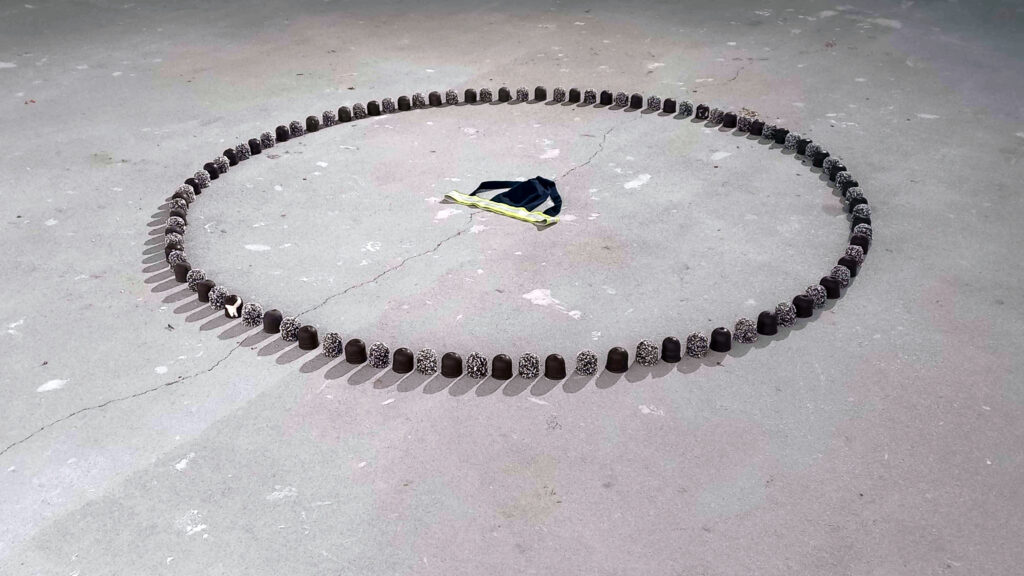
What is Twink Death?
“Twink Death”
“Twink Death” is a term often used in LGBTQ+ circles, particularly online, to describe the perceived loss of the youthful, slim, and boyish physical traits that define the “twink” archetype as someone ages. While it’s a playfully dramatic term, it also points to deeper conversations about beauty standards, ageism, and desirability within queer culture.
A Camp Symbol of Memento Mori
The installation features a carefully arranged circle of Schwedenbomben, evoking a sense of nostalgia, fragility, and impermanence. Their chocolate shells, easily cracked, and marshmallow interiors, soft and yielding—a camp symbol of memento mori. At the center of this circle lies a black jockstrap, its lemon-green waistband immediately capturing attention. The bold color contrast against the dark Schwedenbomben emphasizes its prominence, drawing the viewer’s gaze. Both the candies and the jockstrap relate to sensual pleasures, evoking a bittersweet connection to the fleeting nature of life.
A Queer Ritual?
But where is the body? Is it a summoning, an offering, or both? The circle functions not only as a protective boundary but also as a focal point for the symbolic act of invocation. It enhances the ritualistic undertones of the piece. It serves as a threshold, where the material and the intangible meet, amplifying the tension between presence and absence, desire and loss.
In the background, I’ve chosen paintings from different series to expand on these themes. One series focuses on sexuality and the celebration of queer desires, while the other—two paintings of my grandfather—explores death and commemoration. These works provide a broader context for the installation, reflecting on the interplay between life and death, desire and mourning, personal memory, and cultural narratives.
Felix González-Torres’ use of candies—particularly in his piece Untitled (1991), where he placed piles of individually wrapped candies in galleries—serves as a poignant symbol of loss, especially the loss of his close friend to AIDS.
Similarly, this installation reflects the profound grief I carry from losing my dear friend, Juan Cueto, who tragically took his own life. It speaks to the personal struggles I continue to navigate with depression, compounded by the stigma and isolation still deeply embedded in the fabric of the LGBT community.
According to a 2023 Trevor Project survey, 18% of LGBT youth have attempted suicide—twice the rate of their peers in the general teenage population. This heartbreaking statistic underscores the persistent minority stress that magnifies feelings of invisibility and hopelessness and often leads to the loss of young lives.
Humor as Resistance
Yet, amidst the heaviness, there is room for a wry smile—a bittersweet nod to life’s absurdities. The Schwedenbomben and jockstrap are a playful juxtaposition, combining indulgence and intimacy with the inevitability of decline. Humor, after all, is often the queer community’s most powerful form of resistance: a way to embrace our fragility while laughing in the face of despair. This piece stands as both a personal tribute to Juan and a call for solidarity, visibility, and care within our community.
Michał Rutz
“Twink Death” is a term often used in LGBTQ+ circles, particularly online, to describe the perceived loss of the youthful, slim, and boyish physical traits that define the “twink” archetype as someone ages. While it’s a playfully dramatic term, it also points to deeper conversations about beauty standards, ageism, and desirability within queer culture.